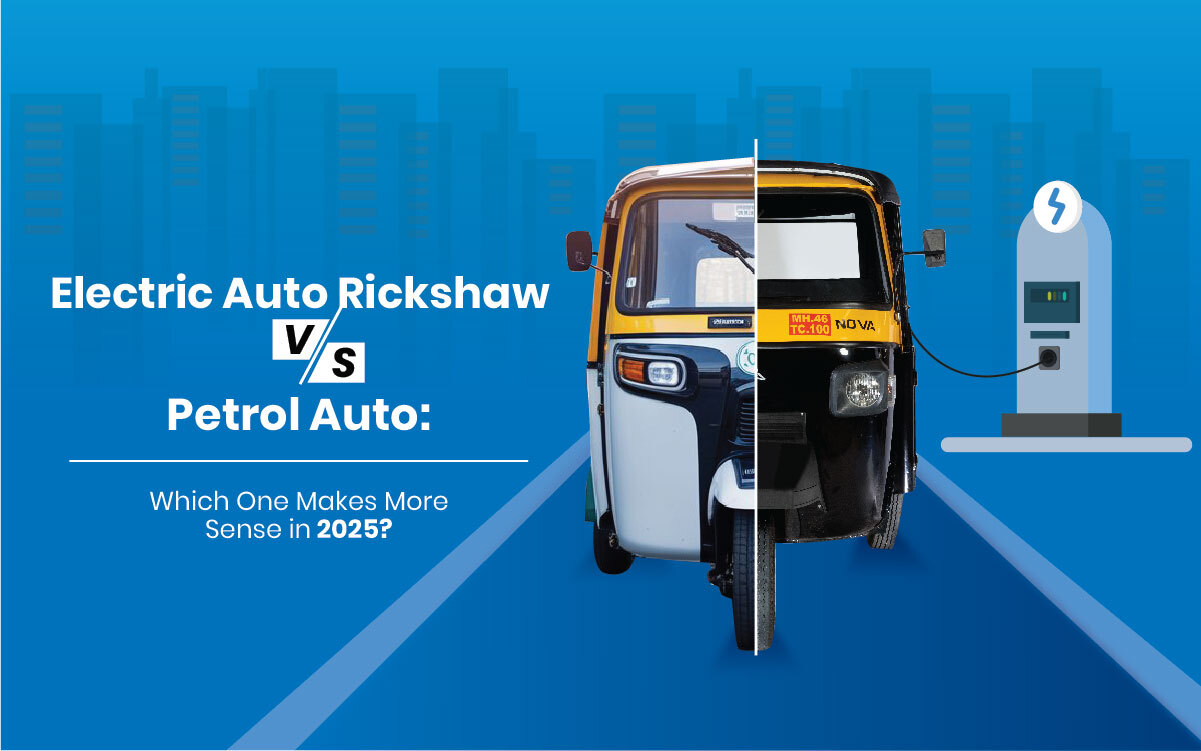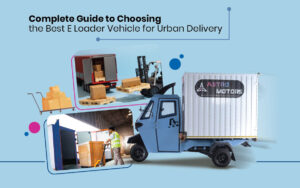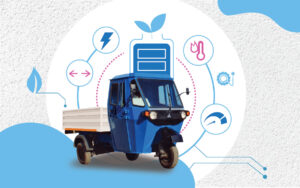In 2025, should you invest in an electric auto rickshaw or stick to a petrol auto? Here’s a detailed comparison to help you decide.
Key Takeaway Summary
- Electric auto rickshaws offer lower running costs, zero emissions, and government incentives.
- Petrol autos still have strong refueling infrastructure and familiarity, but are costlier to operate.
- EV autos like the Astro Nova Electric Rickshaw outperform traditional models in space, range, and economy.
- Battery capacity, payload, range, and operating cost are key decision factors.
- The shift toward EV autos is gaining momentum in India due to cost-efficiency and sustainability goals.
Understanding the Basics: What Is an Electric Auto Rickshaw?
An electric auto rickshaw, also referred to as an e rickshaw, battery auto rickshaw, or EV auto, is a three-wheeled commercial vehicle powered by an electric motor using a rechargeable battery (usually lithium-ion or lead-acid). It is designed for short to mid-range transport and is widely adopted for both passenger and light cargo use in urban and semi-urban areas.
Unlike petrol autos, these vehicles produce zero emissions, have minimal maintenance costs, and are ideal for sustainable mobility.
The Rise of Electric Mobility in India
India is fast-tracking its shift to electric vehicles (EVs), and electric auto rickshaws are a key part of this evolution. According to NITI Aayog, 80% of India’s 3-wheeler market could become electric by 2030. With increasing fuel costs, urban pollution, and government subsidies through schemes like FAME-II, electric autos are now viewed as a long-term solution for cost-effective urban transportation.
Electric Auto Rickshaw vs Petrol Auto: Feature-by-Feature Comparison
| Feature | Electric Auto Rickshaw | Petrol Auto Rickshaw |
| Fuel Type | Electricity (Battery) | Petrol |
| Fuel Cost per km | ₹0.50 – ₹0.80 | ₹2.50 – ₹3.00 |
| Maintenance Cost | Low (fewer moving parts) | High (engine, oil, filters, etc.) |
| Emission | Zero Tailpipe Emissions | CO₂ and other pollutants |
| Subsidies Available | Yes (FAME II & state schemes) | No |
| Charging/Refueling | Needs charging time (2–6 hrs depending on type) | Quick refueling, wide availability |
| Range per charge/litre | 100–150 km per charge (EVs) | 200–250 km per tank |
| Noise Pollution | Minimal | Noticeable engine sound |
| Driver Comfort | Depends on build; top models offer better space | Varies by model; often cramped |
Cost Efficiency: EV Auto vs Petrol in Real-World Usage
A daily-driving comparison for a 100 km/day usage:
| Parameter | Electric Auto Rickshaw | Petrol Auto Rickshaw |
| Running Cost/km | ₹0.70 | ₹2.75 |
| Daily Running Cost | ₹70 | ₹275 |
| Monthly Cost (25 Days) | ₹1,750 | ₹6,875 |
| Yearly Cost | ₹21,000 | ₹82,500 |
That’s a savings of ₹60,000+ annually, making EVs a clear winner for commercial operators.
Spotlight: Astro Nova – A Benchmark in Electric Auto Rickshaw Segment
Without diverting from the blog’s informative tone, it’s worth noting standout models that are shaping the future of electric mobility in India.
🚀 Introducing Astro Nova Electric Rickshaw – “Auto ka SUV”
Built by Astro Motors, the Astro Nova Electric Rickshaw is designed to combine performance, space, and reliability—making it a top choice in the battery auto rickshaw space for 2025 buyers.
| Feature | Specification |
| Battery | 10.24 kWh |
| Range | Up to 220 kms |
| Payload | 435 kg |
| Top Speed | 55 kmph |
| Interior Space | SUV-like spacious cabin |
| Tagline | “Auto ka SUV” |
Its class-leading space, powerful battery, and efficient range make it highly suitable for city commutes and cargo utility alike.
👉 Explore more about Astro Nova Electric Auto Rickshaw.
Environmental Impact: Zero vs Emissions
Electric Auto Rickshaw:
- Emits zero tailpipe emissions.
- Reduces urban air pollution.
- Minimal noise pollution—ideal for city environments.
Petrol Auto:
- Emits CO₂, NOx, and other pollutants.
- Major contributor to city smog.
- Noise pollution is a concern in populated areas.
With India pledging to reduce carbon intensity under COP commitments, adopting electric rickshaws is aligned with national sustainability goals.
Ownership Experience & Maintenance
Electric Auto:
- No oil changes, engine repairs, or complex mechanical parts.
- Fewer breakdowns and lower servicing frequency.
- Initial cost is offset by low long-term expenses.
Petrol Auto:
- Requires regular oiling, filter changes, engine tuning.
- Higher frequency of mechanical repairs.
- Increasing fuel costs make it less viable year-on-year.
Who Should Choose What?
Choose an Electric Auto Rickshaw if:
- You drive over 80 km/day (high savings on fuel).
- You operate in urban areas with charging support.
- You want to reduce maintenance costs.
- You’re eligible for government subsidies or financing.
Choose a Petrol Auto if:
- You live in rural areas with limited charging infrastructure.
- You need instant refueling.
- You want a lower upfront cost (though EV prices are closing in).
Future Outlook – Is 2025 the Tipping Point?
Yes. The combination of government policy, public EV awareness, and rising operational savings makes 2025 a strategic year to switch to electric. With options like Astro Nova leading the EV pack in performance and durability, the petrol auto’s dominance is now under real pressure.
Frequently Asked Questions (FAQ)
❓ Is electric auto better than petrol auto for city driving?
Yes. Electric autos are cheaper to run, easier to maintain, and produce no emissions—ideal for urban use.
❓ What is the range of a battery auto rickshaw?
Top models like Astro Nova offer a range of up to 220 km per charge, which is sufficient for most daily needs.
❓ Are electric auto rickshaws safe and reliable?
Yes. EV autos meet all safety standards and are more stable due to lower center of gravity. Models from reputed brands offer excellent build quality.
❓ How long does it take to charge an electric auto?
Charging time depends on the battery and charger type—typically between 2 to 6 hours.
❓ Are subsidies available for EV autos in 2025?
Yes. Central and state governments offer PM E Drive subsidies, registration waivers, and low-interest loans.
Final Verdict: Which Makes More Sense in 2025?
For most use cases—especially in urban, commercial, and delivery sectors—electric auto rickshaws offer better economics, lower maintenance, and sustainability advantages over petrol variants. The Astro Nova Electric Rickshaw reinforces this shift with superior space, modern battery specs, and road-ready efficiency.
In 2025, making the switch to an EV auto isn’t just logical—it’s essential.




